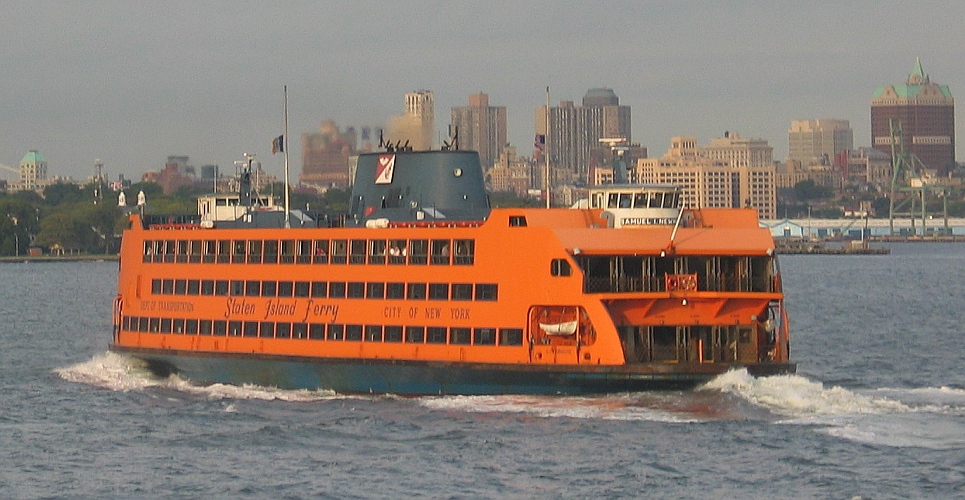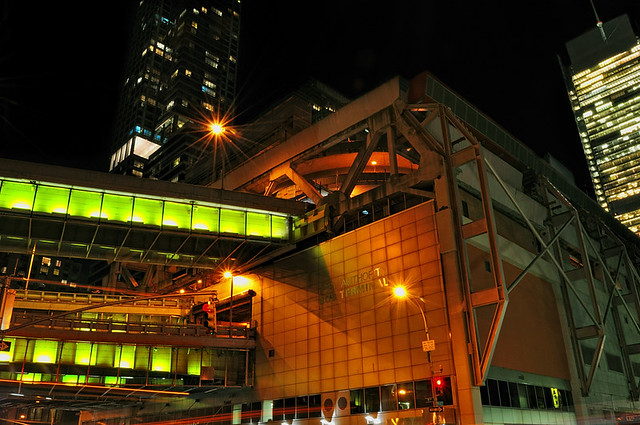
A Staten Island ferry forges forward.
With the chance to elect a brand new mayor for the first time in 12 years staring New Yorkers in the face, the vagaries of electoral politics with a mix of extreme weather-related concerns lead to an outsized focus on some minor issues. When it comes to transportation, we’ve seen candidates obsess about buses, and lately, ferries have garnered some headlines as well. Candidates and representatives just love to talk about ferry service.
Lately, two distinct ferry routes have taken center stage. One involves a current initiative to provide ferry service from the Rockaways to the isle of Manhattan. This route sprang up after Sandy cut off the peninsula’s subway connection, but it’s hardly a new idea. Time and time again, this ferry route has failed due to high operating costs and low ridership. The current service costs just $2 and has seen ridership of around 700 a day. It will be extended through Labor Day, but the city won’t say at what cost.
In the grand scheme of New York City spending, the $4 or $5 million spent on a stopgap measure designed to alleviate the stress of post-hurricane travel won’t make or break anything. It’s worrying to see the city stay mum on costs when ferry subsidies far outpace per-passenger spending on buses or subways. But if the Rockaway ferry is a short-term measure, that’s fine. Budget watchdogs and transit advocates can raise a stink if this goes on forever. That other ferry service, though, warrants more of a look.
Staten Island residents and politicians are calling for expanded Staten Island ferry service, and they’re making a compelling case for it. With a slew of candidates scouring Staten Island for votes, the time may be ripe for a movement toward increased ferry service. In mid-May lawmakers issued a call for added overnight and off-peak service. Right now, ferries operate just once per hour overnight during the week and after 7 p.m. on Saturdays. This past week, the Staten Island Advance’s editorial board picked up the call:
The fact is that a lot of people rely on the ferry during off-peak hours to get them to overnight jobs or return from a night on the town or visiting friends or relatives. They live in the city that never sleeps too. The administration certainly wouldn’t stand for one-hour waits for subway riders in Manhattan or Brooklyn, no matter what the time of day. But it’s only Staten Island, after all, and the members of this administration, who call the Upper West Side or Park Slope and Cobble Hill home, figure Staten Islanders have little need for round-the-clock transportation. Besides, then too, in their eyes, the ferry is primarily a tourist attraction, not a necessary a critical transportation service for city residents…
Another provision of the compromise back in 2004 was that the DOT had to conduct studies of ferry ridership and provide them to the Council. [Assistant DOT Commissioner Kate] Slevin cited low off-peak ridership at several points but couldn’t provide any data. Perhaps the fact that there are a surprisingly high number of people who take the ferry after 7 p.m. on Saturday and Sunday and even after midnight on weekdays explains the DOT’s reluctance to provide the Council with a more thorough ridership analysis. DOT doesn’t want to know how many off-peak riders there really are.
But again, that’s not the point. People should not be stranded in a waiting room for an hour in the self-anointed “greatest city in the world.” All New Yorkers should be able to access adequate, reliable mass transit services from one borough to another. On Staten Island, with no subway, that’s the ferry.
The 2004 compromise mentioned by the paper involved an agreement between the Mayor’s Office and the City Council to increase peak-hour and daytime service while maintaining hour-long headways at night. The City Council had asked for service every 30 minutes, but the Mayor threatening to bring a costly suit to maintain service levels at every 60 minutes. The agreement rested on ridership levels that DOT is hesitant to release.
I certainly feel more frequent ferry service would behoove the city as a whole, and the mayor is pushing forward on a plan to bring a 625-foot-tall ferris wheel and giant shopping mall to within steps of the ferry terminal. Such attractions scream out for more frequent ferry service.
But let’s propose something else: Why not put this effort into some serious planning for a Staten Island subway connection — and one that would obviate the need for any ferry service? As it stands today, the city invests $108 million annually into ferry service. The initial capital costs for a subway to the ferry terminal would probably run upwards of $5 billion — or 50 years of ferry subsidies — but subway service would generate revenue. Fares would be collected, and the one-seat, high-speed connection would lead to an increase in property value and tax revenue for the city too. A more rigorous study for the ridership and cost projections could boost this argument, but you see where I’m going with it.
New York City has such a tenuous relationship with its waterfront due to years of development patterns that prioritized heavy industry and cars over people and job centers, but ferries still have their roles to play. It seems that Staten Island needs more frequent ferry service. With the increased attention over the next few months on what is often a forgotten borough when it comes to transportation, perhaps now the stars will align for a few more boats.




















 It took until the wee hours of the night on Thursday, but the New York State Senate, with little fanfare, finally got around to
It took until the wee hours of the night on Thursday, but the New York State Senate, with little fanfare, finally got around to